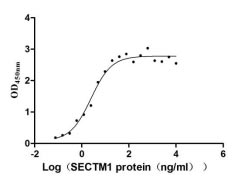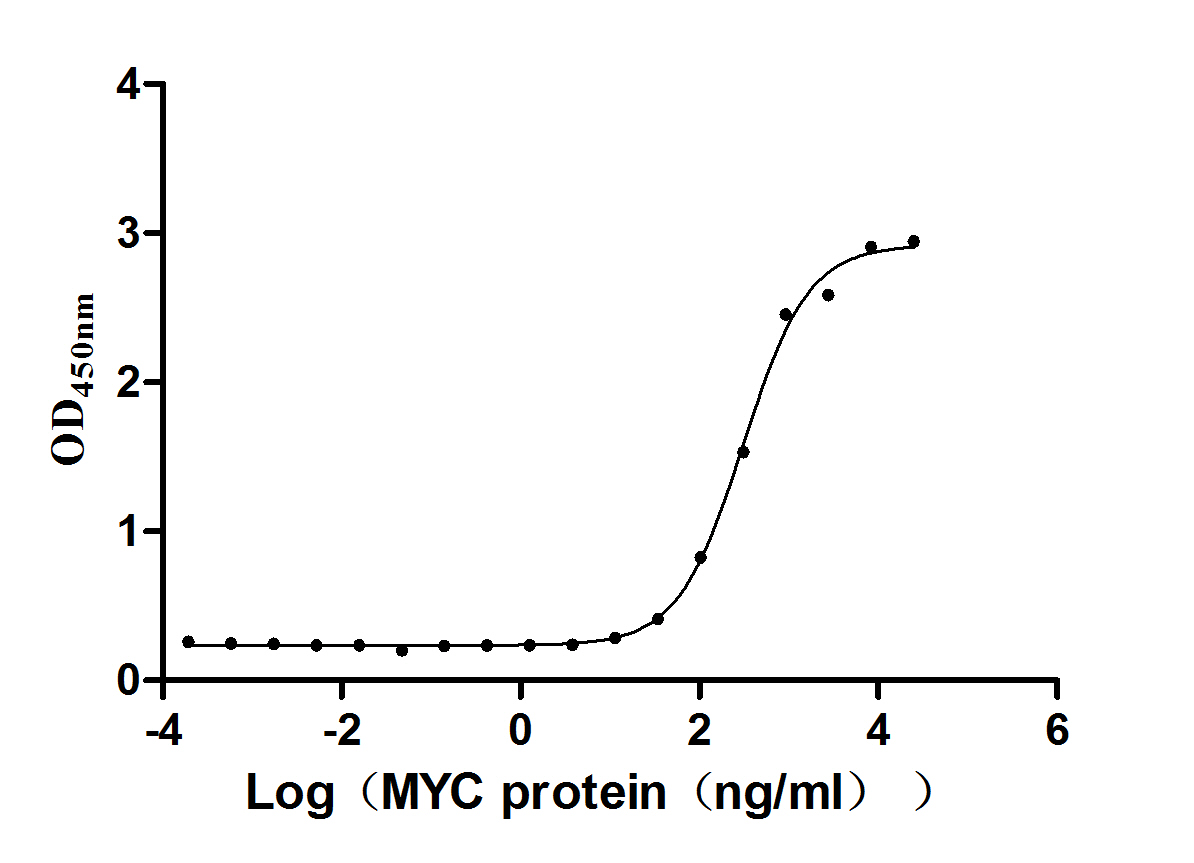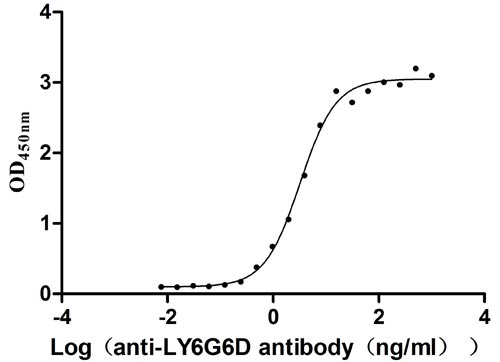Recombinant Human Paxillin (PXN)
-
货号:CSB-YP019112HU
-
规格:
-
来源:Yeast
-
其他:
-
货号:CSB-EP019112HU
-
规格:
-
来源:E.coli
-
其他:
-
货号:CSB-EP019112HU-B
-
规格:
-
来源:E.coli
-
共轭:Avi-tag Biotinylated
E. coli biotin ligase (BirA) is highly specific in covalently attaching biotin to the 15 amino acid AviTag peptide. This recombinant protein was biotinylated in vivo by AviTag-BirA technology, which method is BriA catalyzes amide linkage between the biotin and the specific lysine of the AviTag.
-
其他:
-
货号:CSB-BP019112HU
-
规格:
-
来源:Baculovirus
-
其他:
-
货号:CSB-MP019112HU
-
规格:
-
来源:Mammalian cell
-
其他:
产品详情
-
纯度:>85% (SDS-PAGE)
-
基因名:
-
Uniprot No.:
-
别名:FLJ16691; FLJ23042; Paired box protein Pax 1; PAX 1; PAX1; PAXI_HUMAN; Paxillin alpha; Paxillin; PXN; PXN protein
-
种属:Homo sapiens (Human)
-
蛋白长度:Full length protein
-
表达区域:1-591
-
氨基酸序列MDDLDALLAD LESTTSHISK RPVFLSEETP YSYPTGNHTY QEIAVPPPVP PPPSSEALNG TILDPLDQWQ PSSSRFIHQQ PQSSSPVYGS SAKTSSVSNP QDSVGSPCSR VGEEEHVYSF PNKQKSAEPS PTVMSTSLGS NLSELDRLLL ELNAVQHNPP GFPADEANSS PPLPGALSPL YGVPETNSPL GGKAGPLTKE KPKRNGGRGL EDVRPSVESL LDELESSVPS PVPAITVNQG EMSSPQRVTS TQQQTRISAS SATRELDELM ASLSDFKIQG LEQRADGERC WAAGWPRDGG RSSPGGQDEG GFMAQGKTGS SSPPGGPPKP GSQLDSMLGS LQSDLNKLGV ATVAKGVCGA CKKPIAGQVV TAMGKTWHPE HFVCTHCQEE IGSRNFFERD GQPYCEKDYH NLFSPRCYYC NGPILDKVVT ALDRTWHPEH FFCAQCGAFF GPEGFHEKDG KAYCRKDYFD MFAPKCGGCA RAILENYISA LNTLWHPECF VCRECFTPFV NGSFFEHDGQ PYCEVHYHER RGSLCSGCQK PITGRCITAM AKKFHPEHFV CAFCLKQLNK GTFKEQNDKP YCQNCFLKLF C
-
蛋白标签:Tag type will be determined during the manufacturing process.
The tag type will be determined during production process. If you have specified tag type, please tell us and we will develop the specified tag preferentially. -
产品提供形式:Lyophilized powder
Note: We will preferentially ship the format that we have in stock, however, if you have any special requirement for the format, please remark your requirement when placing the order, we will prepare according to your demand. -
复溶:We recommend that this vial be briefly centrifuged prior to opening to bring the contents to the bottom. Please reconstitute protein in deionized sterile water to a concentration of 0.1-1.0 mg/mL.We recommend to add 5-50% of glycerol (final concentration) and aliquot for long-term storage at -20℃/-80℃. Our default final concentration of glycerol is 50%. Customers could use it as reference.
-
储存条件:Store at -20°C/-80°C upon receipt, aliquoting is necessary for mutiple use. Avoid repeated freeze-thaw cycles.
-
保质期:The shelf life is related to many factors, storage state, buffer ingredients, storage temperature and the stability of the protein itself.
Generally, the shelf life of liquid form is 6 months at -20°C/-80°C. The shelf life of lyophilized form is 12 months at -20°C/-80°C. -
货期:Delivery time may differ from different purchasing way or location, please kindly consult your local distributors for specific delivery time.Note: All of our proteins are default shipped with normal blue ice packs, if you request to ship with dry ice, please communicate with us in advance and extra fees will be charged.
-
注意事项:Repeated freezing and thawing is not recommended. Store working aliquots at 4°C for up to one week.
-
Datasheet :Please contact us to get it.
相关产品
靶点详情
-
功能:Cytoskeletal protein involved in actin-membrane attachment at sites of cell adhesion to the extracellular matrix (focal adhesion).
-
基因功能参考文献:
- Data suggest that FGFR3 with mutation found in patients with SADDAN (but not FGFR3 with mutation found in patients with TDII) affects cytoskeleton organization in chondrocytes by inducing tyrosine hyperphosphorylation of paxillin. (FGFR3 = fibroblast growth factor receptor 3; SADDAN = Severe Achondroplasia with Developmental Delay and Acanthosis Nigricans; TDII = Thanatophoric Dysplasia type II) PMID: 29242050
- overexpression of Paxillin significantly decreased tumor volume of colorectal cancer; miR-24 was overexpressed in natural killer cells and inhibited paxillin expression. PMID: 29494963
- XIST positively regulated PXN levels by sponging miR-137 in vitro and in vivo. Collectively, our study provided the evidence for the cross-talk between XIST, miR-137, and PXN, shedding light on the therapy for non-small cell lung cancer . PMID: 29337100
- we herein demonstrated that frequent overexpression of PXN in cervical cancer was associated with advanced tumor stage, poor differentiation and metastasis, and poor predictive outcomes PMID: 29318915
- Kindlin supports platelet GPIIB IIIA activation by interacting with paxillin. PMID: 28954813
- we collected paraffin specimens from 85 GBM patients and evaluated the expression pattern of paxillin. Notably, we found that discernable paxillin signals were detected in 67 out of 85 samples. Given that leading edge is critical for cancer cell migration, we propose that NA treatment may be developed into a potential therapy for malignant glioma PMID: 28656206
- Pxn binding to the CD103 cytoplasmic tail triggers alphaEbeta7 integrin outside-in signaling that promotes CD8(+) T-cell migratory behavior and effector functions. PMID: 29021139
- REVIEW of the functions of paxillin in pathological conditions, particularly in cell migration PMID: 28214467
- This study showed that the PXN plays as an oncogene in glioma progression and suggests a new potential biotarget for therapy PMID: 27637748
- The MBNL3 splicing factor promotes hepatocellular carcinoma by increasing paxillin expression through the alternative splicing of lncRNA-PXN-AS1. PMID: 28553938
- These data suggest that paxillin appears to influence major cell functions in a diverse range of prostate and breast cancer models. The responsiveness of cells to environmental factors such as HGF or BME may be influenced by paxillin status, although this seems to be dependent on cell type PMID: 28739717
- The role of paxillin in the aging process of skin cells is reviewed. PMID: 27708212
- interactions between Cat-1 and its binding partner paxillin are necessary to ensure sufficient Akt activation so that cancer cells are able to grow under anchorage-independent conditions PMID: 28100775
- The present findings demonstrated that the anticancer effect of docetaxel induces the apoptosis of prostate cancer via the suppression of the cofilin1 and paxillin signaling pathways, which will assist in setting a stage for the clinical treatment of prostate cancer. PMID: 27035282
- Results showed that the positive rate of PXN was significantly higher in the colorectal adenocarcinoma samples and correlated with TNM stage, distant metastasis and recurrence additionally to cetuximab resistance. PMID: 26530439
- blockade of GD3-mediated growth signaling pathways by siRNAs might be a novel and promising therapeutic strategy against malignant melanomas, provided signaling molecules such as p130Cas and paxillin are significantly expressed in individual cases. PMID: 27068854
- These findings suggest that PXN expression has potential use as a novel biomarker of laryngeal squamous cell carcinoma patients and may serve as an independent predictive factor for prognosis. PMID: 26464671
- Mode of Action of Functionally Important Regions in the Intrinsically Disordered Paxillin PMID: 26928467
- Paxillin was expressed at significantly higher levels in colorectal cancer tissues and might serve as a potential prognostic indicator in patients with colorectal cancer PMID: 26159303
- these data suggested that miR-145 plays a pivotal role in colon cancer through inhibiting cell proliferation migration and invasion, and miR-145 may serve as a tumor suppressor by targeting paxillin gene. PMID: 25973017
- In colorectal cancers PXN was positively correlated with Bcl-2, pBcl-2-S87, and MMP2 expression. PXN promotes Bcl-2 phosphorylation at Serine 87 via ERK activation, increases xenograft tumor formation, and associates with poor patient outcome. PMID: 25826088
- Bcl-2 stabilization by paxillin confers 5-fluorouracil resistance in colorectal cancer. PMID: 25323586
- Fascin-1 and paxillin were expressed in 58% and 43% of infiltrating duct carcinoma cases. There was a significant correlation between fascin-1 and paxillin expression and tumor grade, clinical stage, lymph-node metastasis grade, and HER2 expression. PMID: 26349603
- Suggest paxillin up-regulation and phosphorylation as an important mechanism of vascular remodelling underlying pulmonary hypertension. PMID: 25231004
- During early cell spreading, DLC1 is preferentially localized at the inner/mature adhesions whereas phosphorylated paxillin occupies the outer/nascent focal adhesions. In addition, DLC1 downregulates paxillin turnover PMID: 25448629
- The expression levels of Wnt5a, p-JNK1 and p-paxillin in tumor tissues were correlated with each other. PMID: 24395444
- LPS-induced paxillin phosphorylation at Y31 and Y118 was mediated by c-Abl tyrosine kinase PMID: 25795725
- This chapter outlines recent advances in understanding how paxillin regulates both steroid and growth factor signaling, focusing on the conserved nature of its actions from a frog germ cell to a human cancer cell. PMID: 25182764
- Study provides evidence that phosphorylation of PXN is required for cisplatin resistance in lung cancer cells. PMID: 24096476
- High PXN expression is associated with oral cavity squamous cell carcinoma. PMID: 24894864
- paxillin may promote cell proliferation and inhibit apoptosis in SW480 cells. Paxillin may be a potential metastasis predictor, and an independent prognosis factor of recurrence. PMID: 24451945
- MEKK2 induces paxillin ubiquitylation in breast cancer cells and this function requires both paxillin LD1 motif and MEKK2 kinase activity. PMID: 25190348
- Paxillin knockdown increases capillary endothelial cell migration and invasiveness, and thereby enhances microvessel ingrowth, by suppressing NRP2 expression. PMID: 24522185
- Through HDAC6-dependent regulation of the microtubule cytoskeleton, paxillin regulates both Golgi organelle integrity and polarized cell invasion. PMID: 25070956
- PXN plays an important role in tumor progression and may be used as a potential prognostic indicator in gastric cancer PMID: 24180516
- Future studies investigating these hypotheses on TG-2-paxillin relationships are necessary in order to address this fundamental process in cell matrix adhesion signaling. PMID: 24193434
- The data suggests that mutant PXN variants play a prominent role in mitochondrial dynamics with direct implications on lung cancer progression. PMID: 23792636
- In aneuploid tumors, EZH2 expression and paxillin expression correlate with more aggressive phenotype of breast cancer. PMID: 24344012
- ezrin and paxillin may have roles in aggressive tumor features and invasiveness in urothelial bladder tumors PMID: 21868260
- The paxillin plays vital roles in cell motility through regulation of focal adhesion dynamics. PMID: 22481092
- Lysophosphatidic acid (LPA) induces both time and dose-dependent tyrosine phosphorylation of paxillin and focal adhesion kinase. PMID: 24061591
- Paxillin signaling contributed to tumor growth and vasculogenic mimicry of gallbladder carcinomas. PMID: 23588386
- Mutation of paxillin serine 250 prevents its phosphorylation by SLK in vitro and results in impaired migration in vivo as evidenced by an accumulation of phospho-FAK-Tyr397 and altered FA turnover rates. PMID: 23128389
- Data indicate that lasp-2 interacts with the focal adhesion proteins vinculin and paxillin. PMID: 23389630
- overexpression of PXN induced by suppression of miR-137 promotes tumor progression and metastasis and could serve as an independent prognostic indicator in colorectal cancer patients. PMID: 23275153
- Paxillin is critical for integrating physical cues from the ECM with chemical motility signals by spatially constraining where cells form motile processes, and thereby regulates directional migration. PMID: 23076140
- Fascin-1, ezrin and paxillin contribute to the malignant progression and are predictors of clinical prognosis in laryngeal squamous cell carcinoma. PMID: 23209815
- Paxillin is a new regulator protein of pulmonary arterial smooth muscle cell growth. PMID: 22959909
- phosphorylation of GIT1 on serine 46 by PKD3 represents a molecular switch by which GIT1 localization, paxillin trafficking, and cellular protrusive activity are regulated. PMID: 22893698
- Findings suggest that the MLK3-JNK-paxillin signaling axis may represent a potential prognostic marker in breast cancer metastasis. PMID: 22700880
显示更多
收起更多
-
亚细胞定位:Cytoplasm, cytoskeleton. Cell junction, focal adhesion. Cytoplasm, cell cortex.
-
蛋白家族:Paxillin family
-
数据库链接:
HGNC: 9718
OMIM: 602505
KEGG: hsa:5829
STRING: 9606.ENSP00000228307
UniGene: Hs.446336
Most popular with customers
-
Recombinant Human Secreted and transmembrane protein 1 (SECTM1), partial (Active)
Express system: Mammalian cell
Species: Homo sapiens (Human)
-
Recombinant Human Tumor necrosis factor ligand superfamily member 18 (TNFSF18), partial (Active)
Express system: Mammalian cell
Species: Homo sapiens (Human)
-
Recombinant Human papillomavirus type 16 Protein E7 (E7) (Active)
Express system: E.coli
Species: Human papillomavirus type 16
-
Recombinant Human IGF-like family receptor 1 (IGFLR1), partial (Active)
Express system: Mammalian cell
Species: Homo sapiens (Human)
-
Recombinant Human Tissue factor pathway inhibitor (TFPI), partial (Active)
Express system: Mammalian cell
Species: Homo sapiens (Human)
-
Recombinant Mouse Transthyretin (Ttr) (Active)
Express system: Mammalian cell
Species: Mus musculus (Mouse)
-
Recombinant Human Lymphocyte antigen 6 complex locus protein G6d (LY6G6D) (Active)
Express system: Yeast
Species: Homo sapiens (Human)
-
Recombinant Macaca fascicularis Trophoblast glycoprotein (TPBG), partial (Active)
Express system: Mammalian cell
Species: Macaca fascicularis (Crab-eating macaque) (Cynomolgus monkey)




















